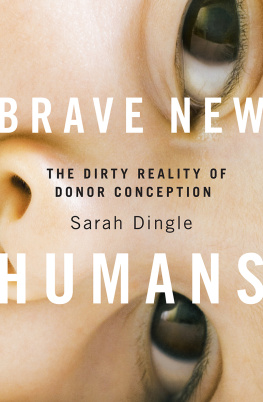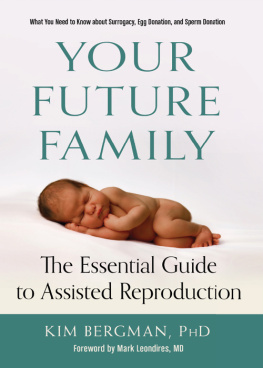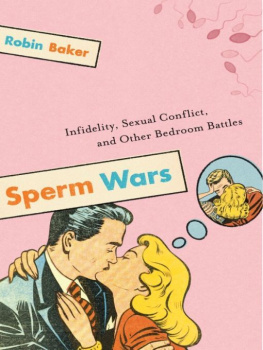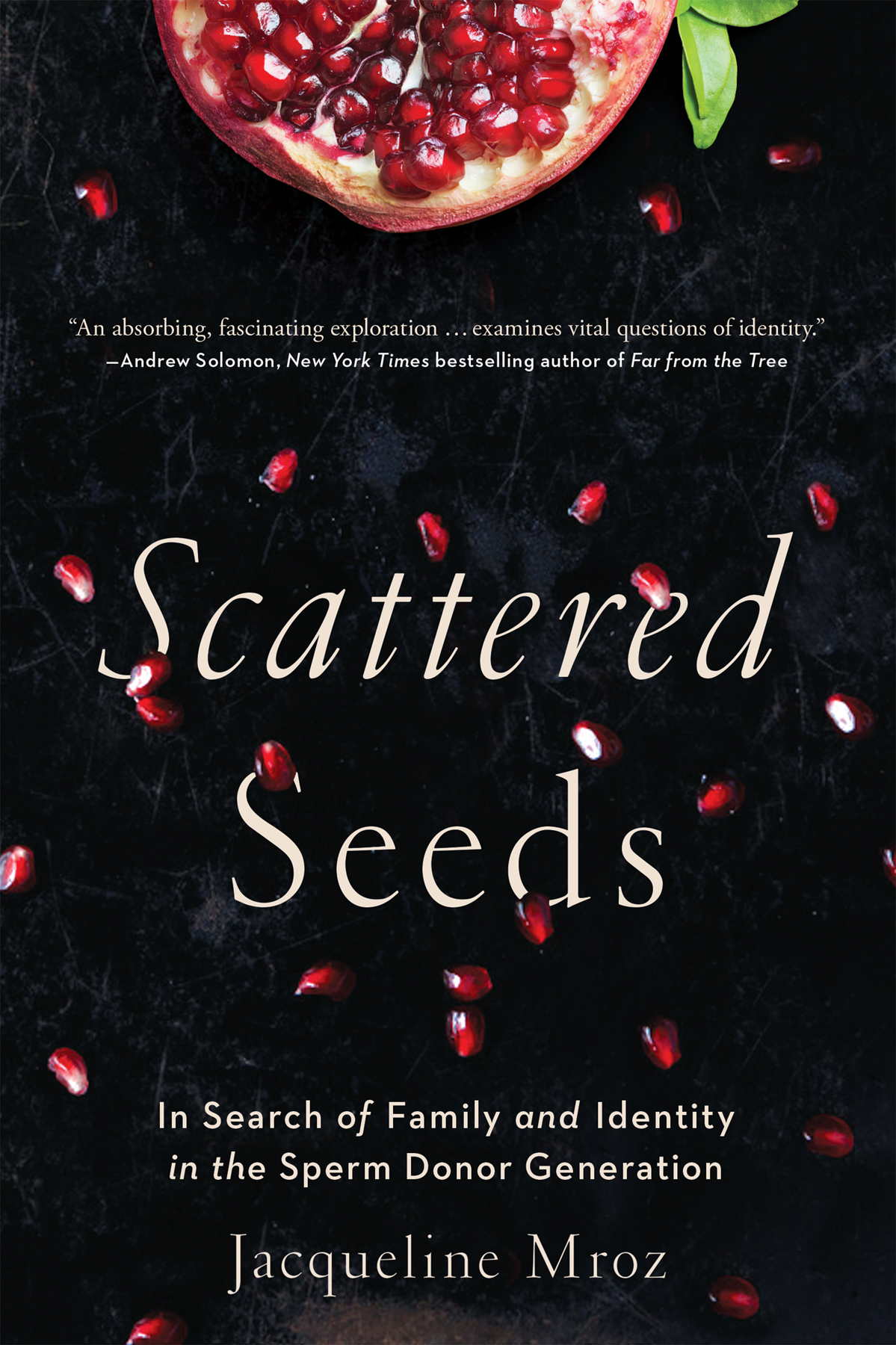All rights reserved. No part of this book may be reproduced or transmitted in any form without written permission from the publisher, except by reviewers who may quote brief excerpts in connection with a review.
Library of Congress Cataloging-in-Publication Data for this book is available.
A subsidiary of Hachette Book Group, Inc. 1700 Fourth Street Berkeley, California
I ts a cold winter day, and my sister and I are sitting at her kitchen table, drinking tea against the cold. We hover over her laptop, checking out profiles of sperm donors on the California Cryobank website. It reminds me a little of the shopping trips we sometimes take togetherexcept this time, instead of browsing the latest styles in dresses and shoes, we are shopping for the man who will father her child. Will it be the tallish anthropology student who likes to hang out with friends and resembles football player Drew Brees, or maybe the blond, blue-eyed athlete who enjoys traveling and spending time with his family, and who looks a bit like actor Paul Bettany?
Profiles of exceptional men parade before our eyes. We bookmark a few standouts and consider paying the extra $250 fee to view the donors childhood photos, staff impressions of him, and a facial features report. Its a little surreal, like The Handmaids Tale for men.
Thats when my sister tells me something incredible. Shed been on a website for single mothers, reading through a forum for women trying to conceive, when she came across a message from a woman who had had a child through a sperm donor. This woman had just found out that her daughterconceived with a sperm donorhad seventy-five half siblings!
The woman had used an open donor so that her daughter could get in touch with her biological father when she turned eighteen, but she now realized there was no way her sperm donor was going to be at all interested in any personal contact with her child.
My sister is understandably upset.
This is freaking me out! I cant believe a child could have seventy-five siblings. I dont know what Id do, she says.
The thought of my niece or nephew having that many half siblings is worrying. There were so many things to consider: would my sister ever get to know the other families? Would her child be able to contact the biological father? How could the donor possibly keep track of all his kids or maintain relationships with them?
Still, Im fascinated. Could one sperm donor actually have fathered nearly a hundred children? What does it mean? Im intrigued and find myself pulled into an investigative journey that will ultimately make me reconsider the very definition of family and the concept of identity.
I speak to my editor at the science section of the New York Times, and he, too, is curious. He wants me to start digging and confirm the story. As I begin my research, I learn that seventy-five kids is, in fact, a relatively small number. There are much larger groups out thereincluding one that is comprised of 150 children.
Its unfathomable. The most children Id ever heard of one man having are a dozen or so (think Anthony Quinn). But 150! I quickly calculate: that means that in 800 years, one donor could have millions of descendants. To put this in context, Genghis Khan, during his global rampage, is thought to have sired the equivalent of 16 million descendants.
Im curious to find out how we got to a place where a man could father so many children. As I begin looking into it, Im surprised to discover that Americas fertility industry is only loosely regulated. Compared with countries such as Britain, which strictly regulates its fertility industry, the U.S. is the Wild, Wild West of baby making.
Here, anything goes.
My New York Times story, One Sperm Donor, 150 Offspring, generated an extraordinary amount of publicity. It was the Times most emailed, most viewed, and most blogged story of the day, and it was picked up all over the world. The Today Show interviewed me for a segment it did on my piece. People were interested. People wanted to know more. Clearly, it had hit a nerve.
.
Susannas experience is just one example of the remarkable changes taking place in human societys central organizing element: the family. And these changes will have profound and widespread consequences on the future of how human beings connect with one another. Todays blended families, gay couples with kids, and children born out of wedlock are almost unrecognizable in makeup compared to the traditional nuclear families of the 1950s. Regardless of how the pieces of todays families may differ from those of a half century before, they all share the same bonding agent: love and kinship.
In the past few decades, the number of women who have decided to reproduce without a male partner has exploded, a development made possible through the growing sophistication and accessibility of assisted reproductive technology. The number of lesbian couples and single women using sperm donors to have children has transformed how families are created today, giving women new choices about how theyd like to structure their family. This change started slowly, but now hundreds of thousands of children are born through donor eggs or sperm in the United States every year and more than one million people born through donor gametes worldwide.
As for the sperm donors, in most cases, they were never told how many kids they would father, or the sperm bank lied to them and said it would only be a few. The concept of having any real relationship with dozens, perhaps hundreds, of offspring must be mind-boggling. One sperm donor who is in touch with his multiple offspring uses an Excel spreadsheet to keep track of them all. Hes not sure what hell do if more of his children are born.
Meetings between sperm donors and their offspring are also becoming more commonespecially as its become easier for children to find their donors through genetic testing and online searches.
Its very difficult to quantify how many of these relationships are taking placeor even how many sperm donors or donor-conceived people are out there. Thats because nobody is keeping tracknot the federal government, not the sperm banks. No one. Thats one of the biggest complaints that critics make of the fertility industry in this country. The most accurate numbers for donor-conceived children are probably on the Donor Sibling Registry (DSR), a website that serves donor offspring and sperm donors, and those are self-reported by the families. However, Wendy Kramer, the founder of the DSR, says that of the 2,800 sperm donors in her database, there have been 1,400 donor to offspring matches (as of March 2017). That means that more than a thousand sperm donors have become connected to their children. And that number is probably even higher now. Its a remarkable concept to considerall these new and complicated families that are being formed at this very moment.
Of course, scores of offspring means dozens of half brothers and sisters. How do donor children make sense of their place in the world when they are one of so many? Not knowing the identity of ones parent can be devastating for some, leading them to relentlessly search for clues as to who they are.






